
We all have our klutzy moments. We trip over a pair of shoes we didn't put away, our foot catches on a bump in the sidewalk or we just don't see that one last stair. While yoga can't prevent all of those less-than-graceful accidents, balancing poses can give you more control and even stop you from falling.
These six poses are meant to help you find balance, challenge your stability and build your core strength. You can put them together into a vinyasa (yoga sequence), holding each pose for one to two cycles of breath, or pick just a few on which to focus, holding the poses for an extended period of time for a more meditative practice (30 to 60 seconds or longer!).
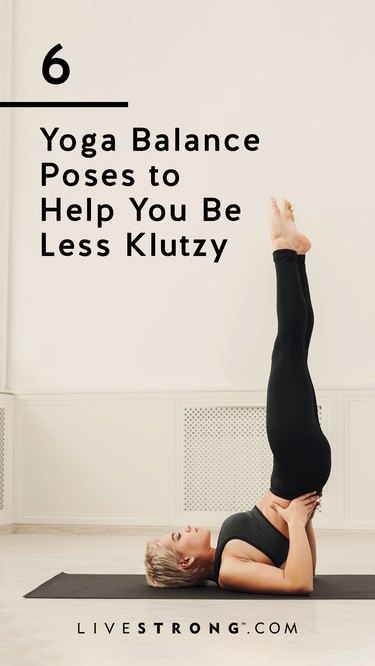
How Yoga Helps With Balance
One of the central pillars of yoga is to seek balance both on and off the mat, according to Yoga Journal. For this reason, certain yoga poses, like the ones below, emphasize balance and alignment in the body. "When we balance, we are aligning our bodies with the force of gravity," says Alexandra Wood, Equinox yoga instructor. "This helps us find a sense of being grounded and centered."
Alongside an ability to improve physical balance and alignment in the body, a regular yoga practice can encourage balance in your day-to-day life, too. For Wood, her yoga has been critical in helping her achieve balance even with her hectic schedule.
"Yoga has not only improved my physical balance, it's helped me to learn how to better balance my personal life by being more mindful and implementing more self-loving rituals into my day-to-day life," she says. "These rituals help me manage stress, anxiety and overall live a healthier and more fulfilling life!"
Other Benefits of Balance Yoga Poses
For day-to-day life tasks and activities, improving your body's balance is one of the best ways to prevent injury, especially injuries related to falling, according to Harvard Health Publishing. And according to an October 2013 study in the BMJ, exercise can reduce the odds of falling and sustaining fall-related injury among people over 60. The benefits of balance practice and poses include:
- Improved stability
- Increased engagement of the core muscles
- Improved strength
1. Plank Pose (Phalakasana)
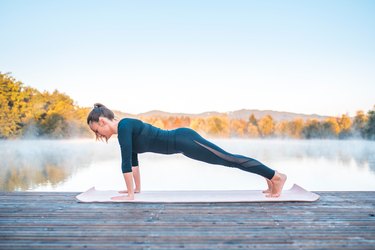
This is a foundational yoga pose with nearly unlimited potential for functional applications. You'll build core strength and teach your body to properly align itself from head to foot — even in a different spatial orientation.
- Begin on all fours with your knees under your hips and your hands under your shoulders.
- Push your feet back behind you and straighten your body so that you're in a perfect line from head to hips to feet. Don't sink into your shoulders and avoid sagging or hiking your hips.
- Hold for 10 breaths.
Read more: The Best Yoga Moves for Your Back
2. Side Plank (Vasisthasana)
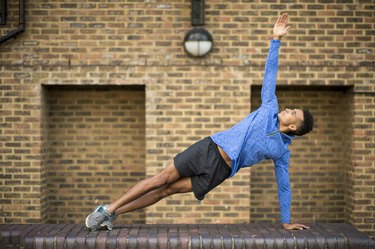
Life isn't always forward and backward. Sometimes you have to know how to deal with the twists and turns. That's where a pose like Side Plank comes in.
- Start in Plank pose (see above).
- Shift onto your right hand and stack your feet so your body forms a straight line from head to hips to feet. Lower onto your right elbow if you have any discomfort in your wrist or shoulder.
- Twist to shift your weight to your left hand.
- Hold for 5 breaths on each side.
Tip
If you're up for a challenge, raise your upper leg in each side plank position.
3. Crow Pose (Bakasana)
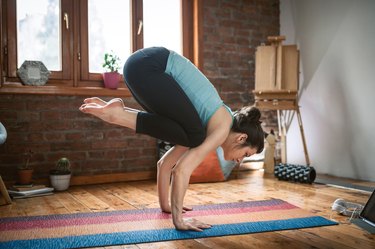
This pose is a slight departure from the other balancing poses in this series, but it's important to incorporate some arm strength into your practice. Plus, you'll still develop plenty of balance and stability in this pose.
- Start standing with your feet several inches apart, feet turned out.
- Bend your knees and place your hands a few inches in front of you.
- Squat down low and bend your elbows in toward your body.
- Place your knees on your triceps and slowly lift one foot off the floor.
- When you're ready, bring both feet off the ground and tuck them toward your glutes.
- Hold for 5 breaths.
Struggling With Crow Pose?
These nine moves will help you finally nail it.
4. Supported Shoulderstand (Sarvangasana)
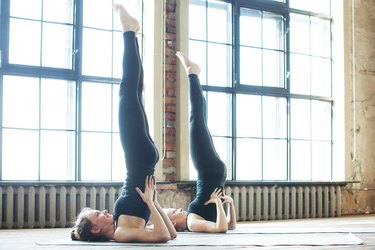
This inversion balance pose can be modified by adding a blanket beneath your shoulders for added comfort. Breathe deeply to maintain your balance as you play with the pose.
- Lie on your back, arms at your sides and feet flat on the ground.
- Bring your hands to your lower back and draw your knees into your chest, one leg at a time.
- Straighten your knees and extend your legs up toward the ceiling until you're in a straight line from neck to feet (stop if you feel too much pressure in your neck).
- Continue to use your hands to support your lower back, upper arms pressing into the ground.
- Hold for 8 breaths.
5. Supported Headstand (Sirsasana)
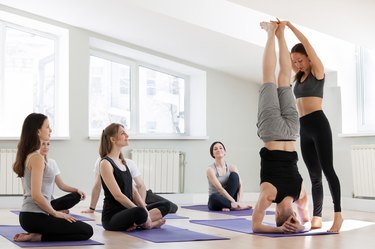
Like the pose above, Supported Headstand will have you up close and personal with your mat. Keep a folded blanket handy to protect the crown of your head.
- Interlace your fingers and set your forearms on the mat, shoulder-width apart.
- Set the crown of your head on the floor, pressing your palms together against the back of your head.
- Lift your knees and walk your feet toward your elbows, heels up.
- Slowly lift your feet away from the floor and straighten your legs up, engaging your core.
- Hold for 10 breaths.
6. Handstand (Adho Mukha Vrksasana)

Handstand is one of the most challenging balance poses. If you're trying it for the first time, take it slow and, ideally, practice with a spotter.
- Begin in Downward Facing Dog. Come up to your toes, shifting your weight into your upper body.
- Bending your knees, lightly hop and tuck your knees into your body.
- Once you feel that you have the balance, engage your core and straighten your legs, feet reaching toward the ceiling.
- Hold for 10 breaths.
Tip
Practice against a wall if you don't have a spotter: Start in Downward Facing Dog with your hands next to the wall so you can kick your legs up to it.